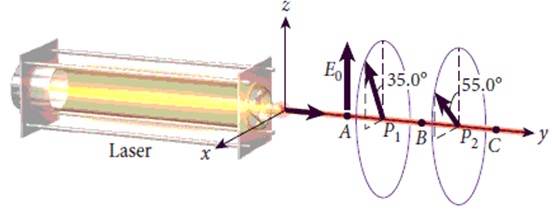Assignment:
Part 1
• A wire of radius 1.0 mm carries a current of 21.0 A. The wire is connected to a parallel plate capacitor with circular plates of radius R = 3.1 cm and a separation between the plates of s = 2.0 mm. What is the magnitude of the magnetic field due to the changing electric field at a point that is a radial distance of r = 1.0 cm from the center of the parallel plates? Neglect edge effects.
• Three FM radio stations covering the same geographical area broadcast at frequencies 94.9, 95.1, and 95.3 MHz, respectively. What is the maximum allowable wavelength width of the band-pass filter in a radio receiver so that the FM station 95.1 can be played free of interference from FM 94.9 or FM 95.3? Use c = 3.0 108 m/s, and calculate the wavelength to an uncertainty of 1 mm.
• A voltage, V, is applied across a cylindrical conductor of radius r, length L, and resistance R. As a result, a current, i, is flowing through the conductor, which gives rise to a magnetic field, B. The conductor is placed along the y-axis, and the current is flowing in the positive y-direction. Assume that the electric field is uniform throughout the conductor. (a) Find the magnitude and the direction of the Poynting vector at the surface of the conductor.
• A laser produces light that is polarized in the vertical direction. The light travels in the positive y-direction and passes through two polarizers, which have polarizing angles of 35° and 55° from the vertical, as shown in the figure. The laser beam is collimated (neither converging nor expanding), has a circular cross section with a diameter of 1.70 mm, and has an average power of 16 mW at point A. At point C, what are the magnitudes of the electric and magnetic fields, and what is the intensity of the laser light?

• A microwave operates at 565 W. Assuming that the waves emerge from a point source emitter on one side of the oven, how long does it take to melt an ice cube 2 cm on a side that is 10 cm away from the emitter if 10% of the photons are absorbed by the cube? Assume a cube density of 0.96 g/cm3. (Also assume that the ice cube is initially at 0°C but has not yet started melting, and that the ice cube maintains its shape until it absorbs enough energy to completely melt.) How many photons of wavelength 10 cm hit the ice cube per second?
Part 2
• A single concave spherical mirror is used to create an image of a source 6.80 cm tall that is located at position x = 0 cm which is xo = 18.0 cm to the left of Point C, the center of curvature of the mirror, as shown in the figure. The magnitude of the radius of curvature for the mirror is R = 13.5 cm. Calculate the position xi where the image is formed. Use the coordinate system given in the drawing. What is the height hi of the image? Is the image upright or inverted (upright = pointing up, inverted = pointing down)? Is it real or virtual?

• A ray of light is incident on an equilateral triangular prism with an index of refraction of 1.29. The ray is parallel to the base of the prism when it approaches the prism. The ray enters the prism at the midpoint of one of its sides, as shown in the figure. What is the direction of the ray when it emerges from the triangular prism?

• In a step-index fiber, the index of refraction undergoes a discontinuity (jump) at the core-cladding interface, as shown in the figure. Infrared light with wavelength 1530 nm propagates through such a step-index fiber through total internal reflection at the core-cladding interface. The index of refraction for the core at 1530 nm is ncore = 1.48. If the maximum angle αmax at which light can be coupled into the fiber such that no light will leak into the cladding is αmax = 13.832°, calculate the percent difference between the index of refraction of the core and the index of refraction of the cladding.

• Refer to the figure below and prove that the are of the primary rainbow represents the 42° angle from the direction of the sunlight.

• A concave mirror forms a real image twice as large as the object. The object is then moved such that the new real image produced is three times the size of the object. If the image was moved 69.0 cm from its initial position, how far was the object moved? What is the focal length of the mirror?
• How deep does a point in the middle of the floor of a 3-m-deep pool appear to a person standing 3.3 meters horizontally from the point? Take the refractive index for the pool to be 1.3 and for air to be 1. (Assume the person is standing in the pool with their eyes just above the level of the water.)